Even for those of us who consider ourselves to be pretty handy within the home improvement world, the thought of pouring self leveling concrete IN OUR HOUSE is moderately terrifying. O.K., completely terrifying. Don't worry. You can do this.
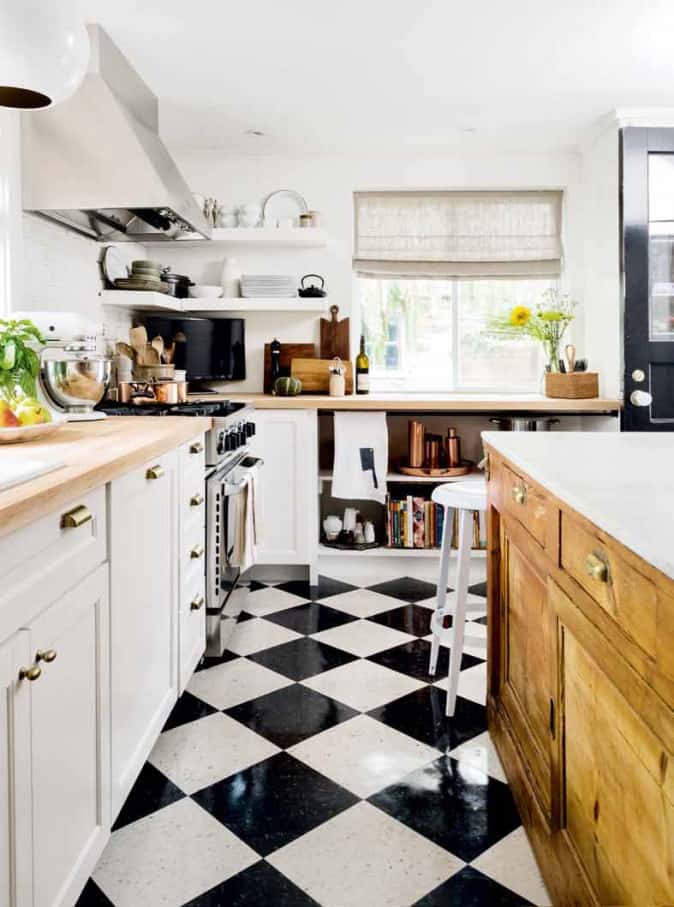
The VCT floor I laid, on top of the cement I poured, over the self installed heated floors.
First things first. I ate a whole can of Pringles today. They were Salt & Vinegar and now my tongue feels like I ate a ball of sandpaper. That might not seem pertinent to the task at hand - and it isn't.
When I redid my kitchen a decade ago I really wanted to address my cold floors. So I ripped out all of my ceramic tile and laid down heated floor mats. That wasn't scary at all. Pouring buckets of self leveling concrete over them WAS.
The cement floor would encase the heating elements, allow them to radiate heat still, plus provide a level smooth surface for tiles. That was my reason for pouring cement all over my floors and working myself into a panic.
Whatever your reason, you don't need to be afraid. I say that because I was afraid. Really afraid. Letter from the tax department afraid. You don't need to be.
Table of Contents
Using Self leveling concrete
Self levelling concrete is cement based like traditional concrete, but it flows much easier and sets up more quickly due to polymers added to it. It's used to create a smooth, level surface for laying carpet, ceramic tiles or other floor coverings on.
For use almost exclusively on interior flooring.
Self leveling cement (concrete) can be poured up to a 1 inch thickness.
Materials
- Self leveling concrete*
- Leveling primer**
- a cement mixing paddle
- a strong drill (rent an industrial one)
- 5 gallon bucket
- trowel
- filler (like Durabond 90)
* It may also be called self leveling concrete, leveling compound, self leveling floor resurfacer or self leveling underlayment. Make sure you get REGULAR instead of QUICK DRYING. Regular will give you more time to work and spread out the material before it starts to set.
** Primer is needed when you're pouring concrete onto a porous surface like an existing concrete floor. It isn't needed when pouring onto old tile.
Method
PREP WORK
- Scrape up any loose debris or old tiles from the floor.
- Fill any cracks or holes with Durabond 90 and create a dam to prevent the runny concrete from seeping anywhere you don't want it to go.
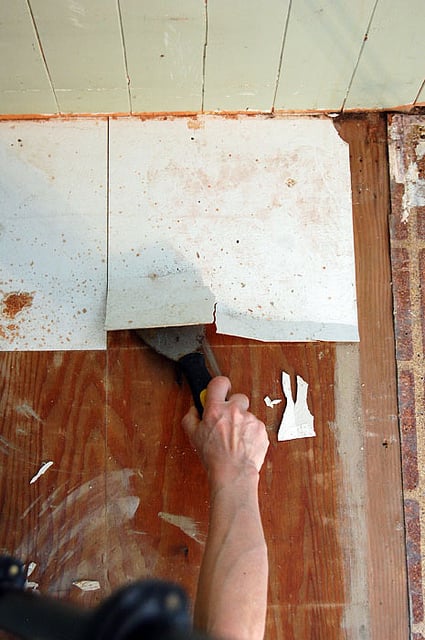
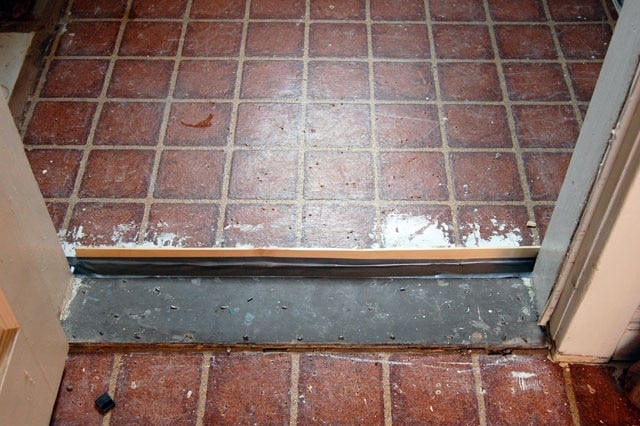
- Vacuum so you have a clean surface.
- Gather your materials.
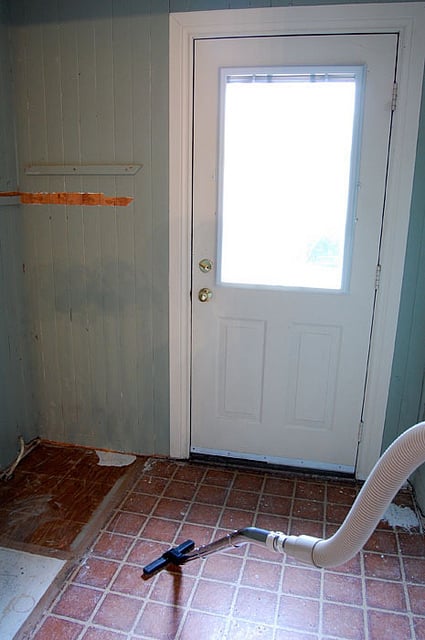
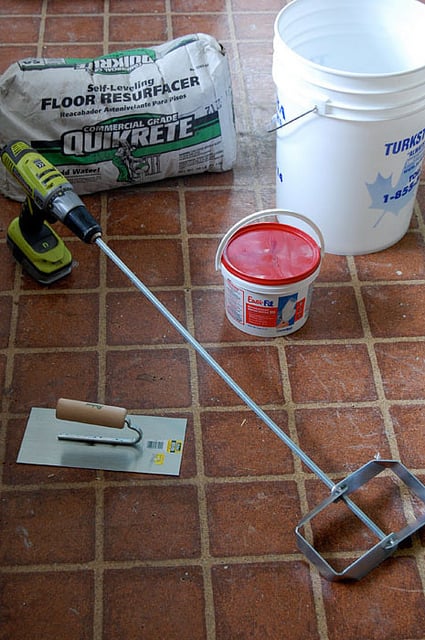
The brand of resurfacer doesn't matter so much as the type. There are 2 types. Quick drying and regular. You want regular.
POURING
- Add the required amount of water to the bucket FIRST. (the bag will tell you how much water to compound mix to use)
- Add ¼ - ⅓ of the powdered compound. Mix with water using the drill. Continue mixing in the remainder of the bag bit by bit until it's all incorporated. Mix for prescribed amount of time as detailed on the bag.
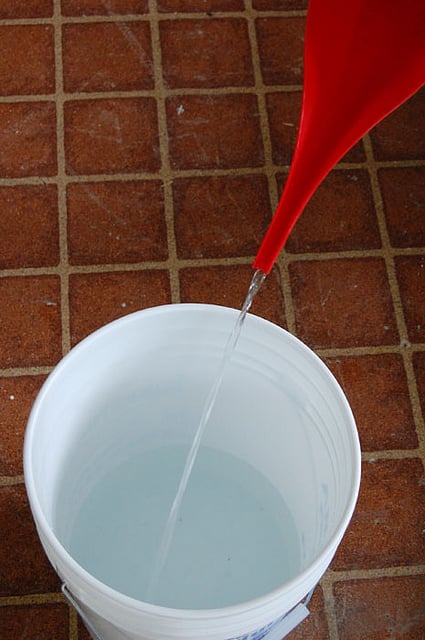
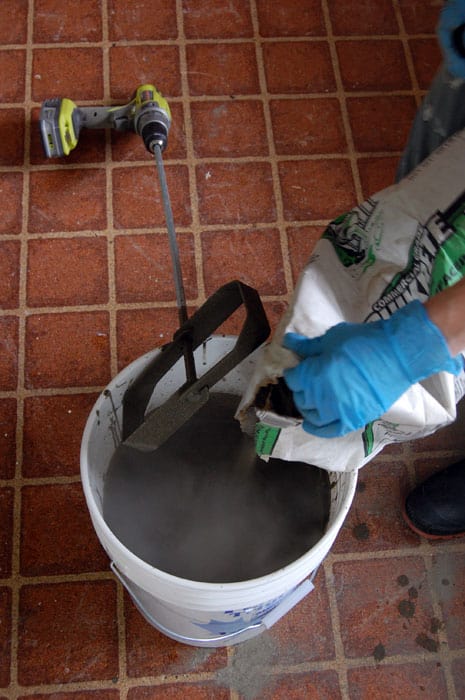
For one bucket of concrete a strong cordless drill will do the job, but if you have any more than 1 bucket to do you're in trouble. The battery will die after 1 or 2 buckets. Then you'll go for your corded drill, which will burn out and will get thrown in the garbage.
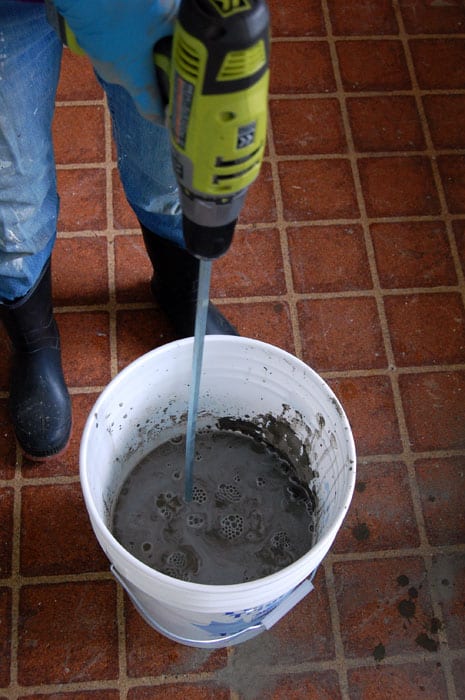
Save your anger, your sanity and your relationship and RENT AN INDUSTRIAL DRILL. After the first day I rented a strong drill for $20 for half a day.
- Pour your leveling compound where you want it.
- Trowel it. Using a trowel push and pull the mixture where it needs to go. Push it into corners and pull it towards you. Excuse my hair. It appears I was having a Paul Weller moment.
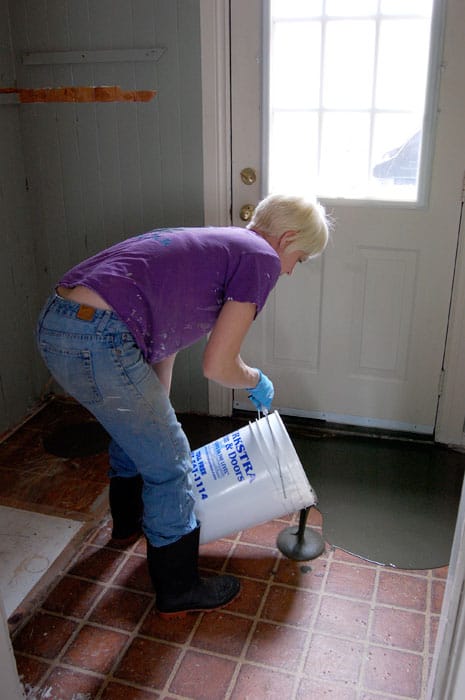
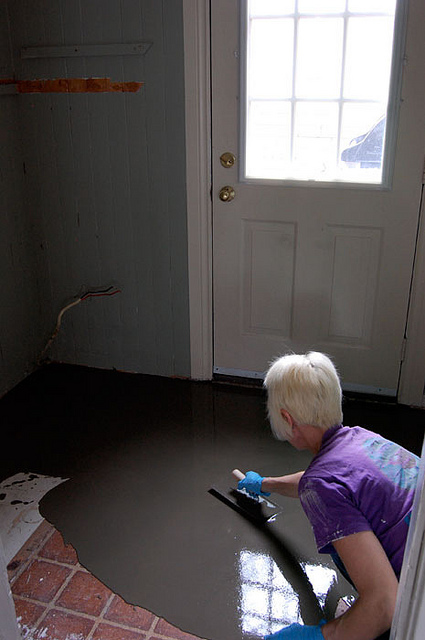
- Clean up your drips.
- Wait 24 hours to walk on it.
- Wait 3 days to place furniture back.
Would you like to save this stuff?
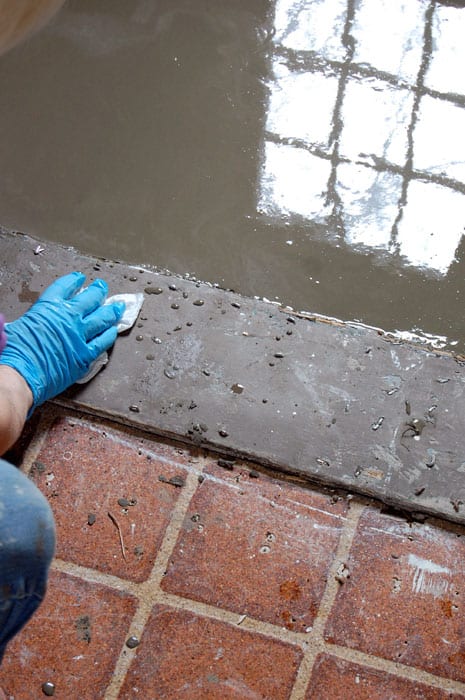
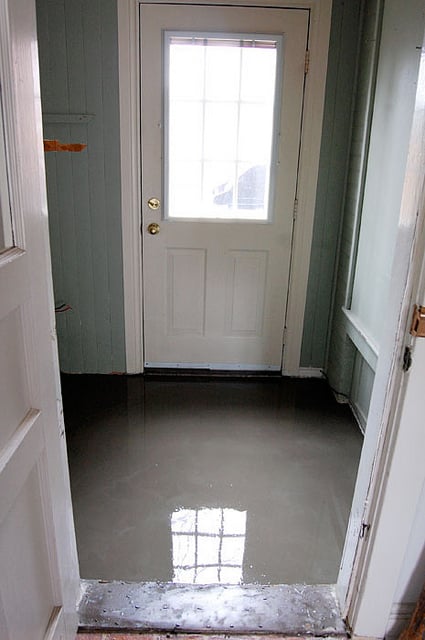
The mudroom went perfectly well. It couldn't have gone better so I continued onto the kitchen where things were a bit tricker.
Tips for Larger Rooms
A bigger room means you have to pour the buckets of concrete, run back to the mixer and mix up another batch (which needs to be mixed a longgg time), run through the house with a 50 pound bucket of cement and pour it where you left off. And repeat.
- Larger rooms are easier to do if there are 2 people working. One mixing the cement and one pouring it.
- Use a stiff squeegee on a long broom handle for pushing and pulling the compound into place.
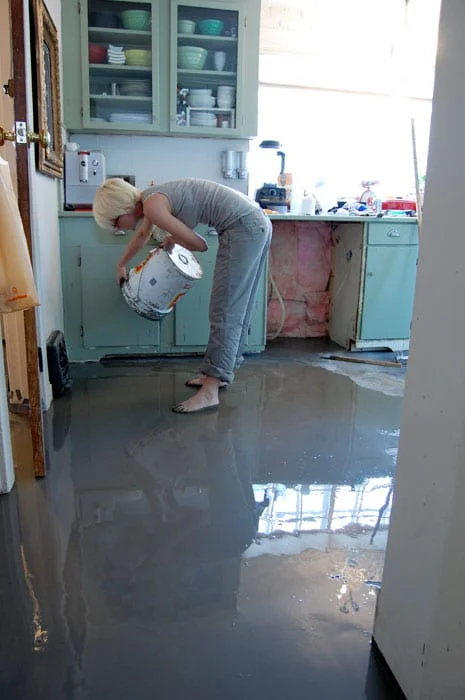
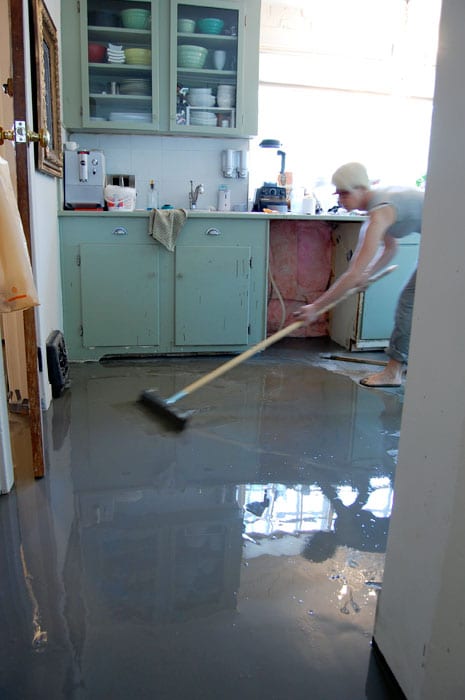
NOTE: Wet concrete is caustic and can burn.
YOU HAVE TO WASH YOUR FEET IMMEDIATELY AFTER YOU WALK THROUGH IT. Do so after every time you walk through it. Also don't walk through wet cement if you have open cuts.
- If you find bits of unmixed lumps of cement. Just mush them with your fingertips.
- You may need to do a second coat if the first coat didn't cover. You could still see the heated floor mats I installed after the first coat, so I did a second.
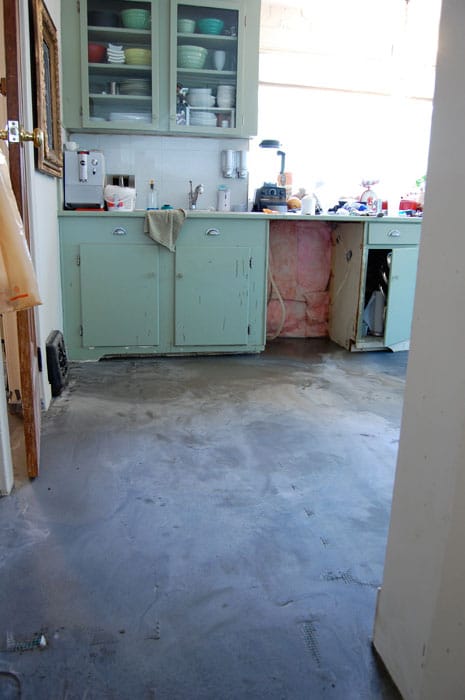
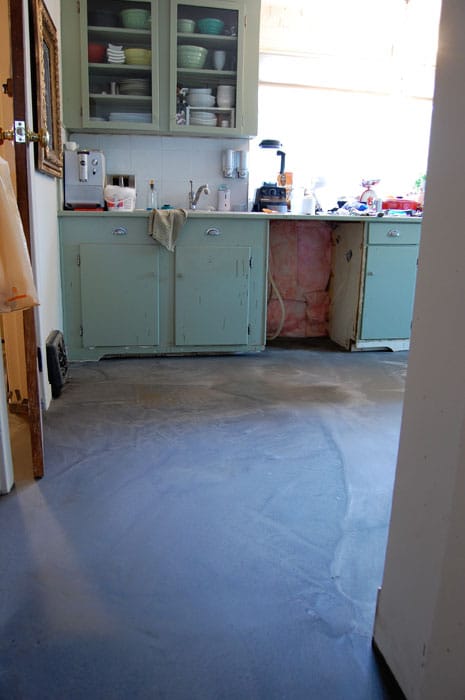
It may look uneven, but it's just an optical illusion. The photo on the right is a levelled floor that is perfectly smooth.
- After leveling if you have any issue with dips and bumps you can correct them with a bit of Durabond 90. (fill, let dry, then sand)
Would you ever want to pour self leveling concrete?
To level an uneven concrete floor.
If you have a wonky basement floor that's uneven you can use self leveling concrete to smooth everything out and get it nice and flat. It's even handy if your concrete floors are just filthy. A thin layer of this will give you nice, clean concrete floors.
To prep a floor for laying down tile or to encase radiant floor heating.
The reason I poured it in my kitchen, bathroom and mudroom was so I could put down radiant floor heating. There's no basement or crawlspace at the back of my house which makes the floors pretty darn cold in the middle of a Canadian winter.
How much does a 50 lb bag of self leveler cover?
How much the cement will cover depends on how thick you will need it to be. This mudroom is around 30 square feet and one 50 pound bag of cement just barely covered it at about ¼" thickness.
Quick drying self leveling cement
Starts to set up in 5 minutes. This is only used when you have a small area to do and are an experienced concrete finisher.
Regular drying self leveling cement
It starts to set up within 15 minutes. This gives the amateur user much more working time. Those extra 10 minutes make a huge difference when you aren't exactly sure of what the hell you're doing.

The Self Leveling Cement *Quick Guide*
A quick guide to pouring self leveling cement. Refer to post for in depth instructions.
Materials
- Regular Self leveling cement*
- Leveling Primer**
- a cement mixing paddle
- a 5 gallon bucket
- a trowel
- filler (Durabond 90).
Tools
- Strong drill (I rented an industrial one)
Instructions
Scrape up any loose debris or tiles from the floor.
Build dams to stop the cement from going anywhere you don't want it to go.*
Fill any holes and/or cracks in the floor that the liquid cement could run down. I use Durabond 90.
Vacuum to get the surface perfectly clean.
Add water to your bucket (amount will be stated on your bag of cement)
Add ⅓ of the bag of cement into the water.
Mix with the drill and cement paddle, continually adding the rest of the bag of cement until everything is incorporated and then mix for the length of time given on the bag.
Here we go. Pour the self leveling cement into the desired area. Push and pull it into place with a trowel. It does self level but needs some help getting around.
And now you wait for it to cure. You can walk on it within 24 hours and place heavy objects back in 3 days.
Notes
*It may also be called self leveling concrete, self leveling floor resurfacer or self leveling underlayment. Either way make sure you get REGULAR self levelling cement. Quick Dry lets you walk on it within 6 hours, but you have a much shorter working time, and for an amateur it's better to have as much working time with the product as possible.
**Primer is needed when you're pouring concrete onto a porous surface like another concrete floor. It isn't needed when pouring onto old tile.
**It's very liquidy so make sure you don't skip this step or you'll have cement running under your dishwasher or down your stairs or into other rooms! I used thin wood, heavy cardboard and duct tape to make dams.
Self levellers can be poured to an inch deep.
If for some reason your cement isn't level, didn't turn out right or wasn't poured quite deep enough, you can re-pour more cement as long as you do it before the initial cement cures. Don't exceed the total recommended depth of 1".
OTHER TUTORIALS REFERENCED IN THIS POST
p.s. I'm out of chips.
→Follow me on Instagram where I often make a fool of myself←
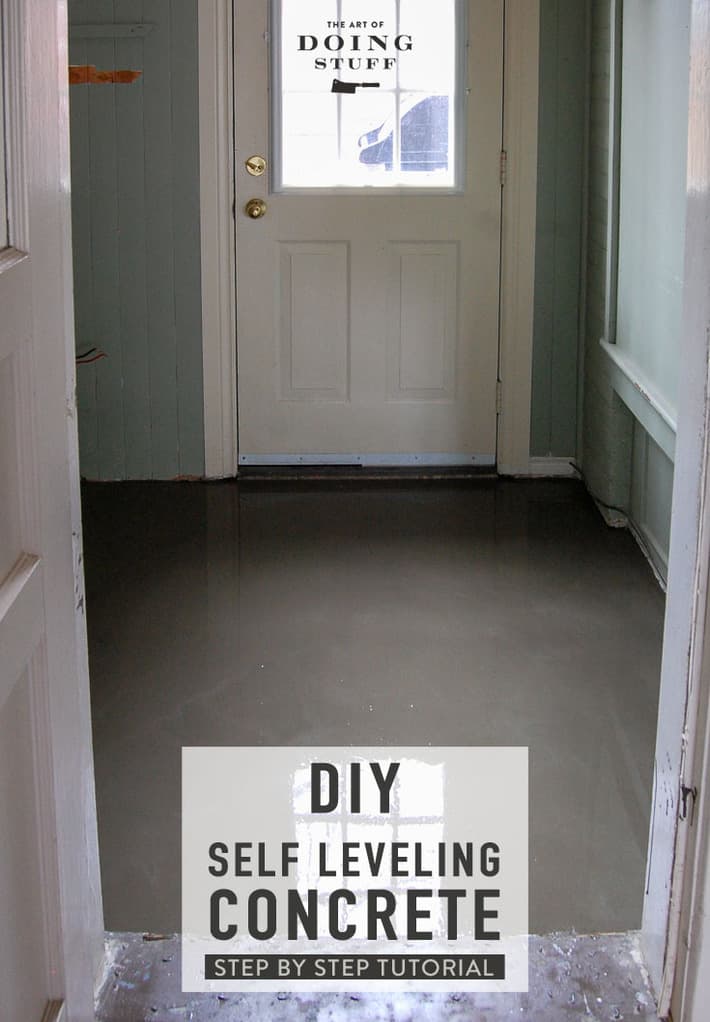

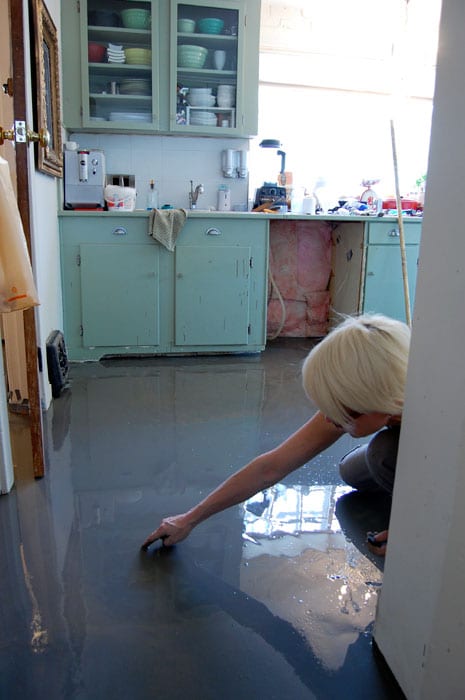
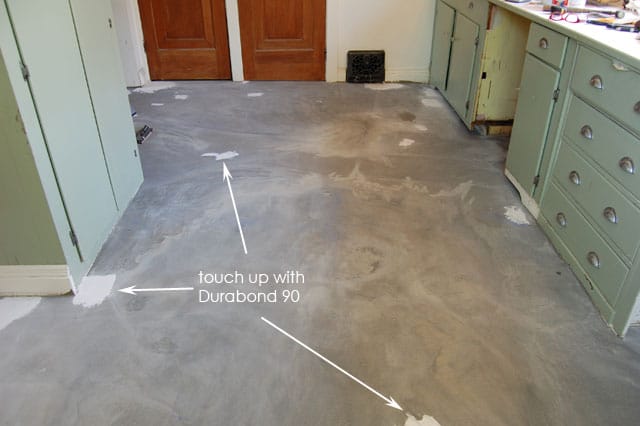

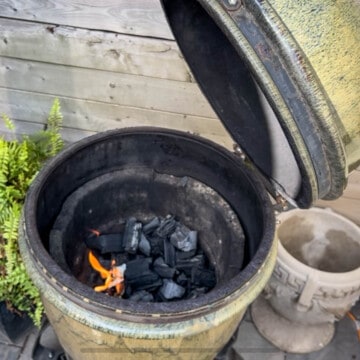


Crystal Marx
Does this get poured right up to your cabinets and walls? I’m wanting to do my entire house and then put epoxy over it and have that be my flooring. I have no heat so also was curious as to how you did your heating?
Leslie
Hi, can you use this over a wood subfloor if its waterproofed and the edges prepped properly? I'm wondering if any flex might crack it? Or should it only be used on existing concrete subfloor? TIA
Kat
A Paul Weller moment…yessss!
Franny
I'm wondering if you can finish/polish the quickcrete and just have a concrete floor if that's what you want? Could you put a dye in it?
Karen
Hi Franny! I get that question a lot. Since I've never done it myself I can't comment on it too much from experience. All I can tell you is that I do know you can use it as a regular, finished floor. The steps to get it that way I don't know however. So I guess the good news is it is possible, the bad news is I don't know how, lol. But keep Googling and you should find the information. ~ karen!
Crystal Marx
Yes you can I YouTubed it and have photos of it. I plan on doing it. 😊
Randy P
So... amazing lovely lady.... what would ten year older Karen tell her ten year younger lovely self about using self-leveling concrete? Take your time and give it a go? Call a concrete person? Move? Just wunderin' on a Chicago's eve. And yes, I stand by my characterization of you as an amazing and lovely lady.
Lois
My heated bathroom floor is my favorite thing in the house. Possibly in my life, at the moment.
G. Bruce Chapman
Add to your equipment list a set of big goggles. Big enough to fit tightly over your eyes (and glasses if wearing), while you are mixing the concrete. Your finger might still be on trigger of the drill when you lift it out of the mix, causing a highland fling of wet mix everywhere. If you get any wet concrete mix splashed in your eyes, it could cause chemical burns. Flush eyes immediately and if irritation continues, seek medical help.
I only received splashes to my expensive glasses, with the concrete etching into the coating. $400 specs ruined! :-(
Karen
Good tip G. ~ karen!
Vicki
The Qhow do you remove the self leveling floor. We used it for a ramp for the shower, but now we want the regular floor back.
Stefan Robert
Gracious amazing, I'm so intrigued! Is there nothing you can't do?? I don't think I know any other individual who can eat a whole jar of Pringles!!! Approach to go!
TucsonPatty
Especially Salt and Vinegar!! She is an amazing woman, that’s for sure!! Never doubt her capabilities!! (Karen, I know that tongue problem! Salt and Vinegar are so good and so hard on your whole mouth!) 😋😋
Paula G
When we moved into this house twelve years ago, we had it re-floored in slate because it was cheap, which turned out to be a HUGE mistake because my floors are the bane of my life. The slate tiles are rough and uneven so the grout lines are as well. Crud gets stuck in them and doesn't sweep out. They are a bitch to get clean, they are a bitch to keep clean. I absolutely hate my floors. I figured that eventually we'd find a bit of acreage and move, but that ain't gonna happen. So I'm stuck with them. I recently advised my husband that if we're going to stay here (his idea) then we're going to have to replace the flooring because as I get older, these floors are going to be more and more treacherous- I'm already constantly tripping over uneven tiles and if I fall as an old woman, I am going to break a hip on them. I also pointed out that if my heart stops again and I pass out, I could do worse damage to myself hitting the floor with my head. So we. have. to. replace. the. floors. He wasn't happy. Also being a handy type, I've built all kinds of bookcases and built-in furniture (daybed and storage benches), so we can't just rip up the tiles. Enter self-leveling cement!! I didn't even know the stuff existed! We might be able to pull off resurfacing the floors by ourselves! Thank you so much for reposting this one!!
Karen
Yay! I'm glad the reminder helped. :) With the slate you'll need to use a primer, but it should work perfectly to level things out and give you a fresh start. ~ karen!
Vikki
No wonder you're thin---that's a hella workout!! But so worth it--your kitchen now is beautiful. Thanks for doing all the research and trials for us. A great post!
Karen
Thanks Vikki! ~ karen
John Spiegel
Great walkthrough, thanks!
I've been doing research on this (hence finally finding this site). There are a couple considerations on the question of whether to prime or not to prime. One commenter noted that primer helps it stick and can reduce cracking down the road. I had a project a while back where I didn't prime and in spots where the leveler was thin I could hear the cracking as I walked on the floor.
Also, about 13:00 in, this video: https://www.youtube.com/watch?v=vc_5eAKILiY gives a good explanation for using primer on concrete especially (I know your case was tile). Since concrete is porous, not priming can allow water to drain out of the leveling compound before the chemical reaction completes, which can lead to a weakened product.